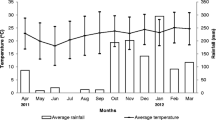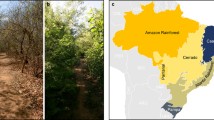Abstract
Tetragonula carbonaria and Austroplebeia australis are two species of eusocial stingless bees with phylogeographically different origins that can occur sympatrically on the Australian east coast. We studied their foraging activity and resource intake and found pronounced differences between species. Tetragonula carbonaria showed consistently higher flight activity (resulting in a higher sugar intake per minute) and thus likely collected more resin and more pollen from a broader plant spectrum than A. australis. In contrast, the smaller A. australis colonies tended to collect a narrower resource spectrum and focused on high-quality resources (i.e., nectar of significantly higher sugar concentrations). Tetragonula carbonaria colonies also gained more weight over the study period than A. australis colonies, but colony growth may nevertheless be similar between the two species, albeit resulting from differences in resource allocation and exploitation as well as worker lifespan. Given their overlapping geographic ranges, T. carbonaria and A. australis may have evolved different patterns with regard to the use of resources to avoid exploitative competition between species or due to constraints imposed by their different phylogeographic origins.




Similar content being viewed by others
References
Bartareau, T. (1996) Foraging behaviour of Trigona carbonaria (Hymenoptera: Apidae) at multiple-choice feeding stations. Aust. J. Zool. 44, 143–153
Bates D., Maechler M., B. Bolker, (2013). lme4: Linear mixed-effects models using S4 classes. R package version 0.999999–2.http://CRAN.R-project.org/package=lme4
Beardsell, D.V., O’Brien, S.P., Williams, E.G., Knox, R.B., Calder, D.M. (1993) Reproductive biology of Australian Myrtaceae. Aust. J. Bot. 41, 511–526
Begon, M., Harper, J.L., Townsend, C.R. (1990) Ecology: individuals, populations and communities. Blackwell Scientific Publications, Boston
Biesmeijer, J.C., Slaa, E.J. (2004) Information flow and organization of stingless bee foraging. Apidologie 35, 143–157
Biesmeijer, J.C., Slaa, E.J. (2006) The structure of eusocial bee assemblages in Brazil. Apidologie 37, 240–258
Biesmeijer, J.C., Richter, J.A.P., Smeets, M., Sommeijer, M.J. (1999) Niche differentiation in nectar-collecting stingless bees: the influence of morphology, floral choice and interference competition. Ecol. Entomol. 24, 380–388
R Development Core Team, (2013) R: a language and environment for statistical computing, URL http://www.R-project.org, R Foundation for Statistical Computing, Vienna.
Dollin, A.E., Dollin, L.J., Sakagami, S.F. (1997) Australian stingless bees of the genus Trigona (Hymenoptera : Apidae). Invertebr. Taxon. 11, 861–896
Dollin A., K. Walker, T. Heard, (2009) “Trigona carbonaria” sugarbag bee (Tetragonula carbonaria). PaDIL - http://www.padil.gov.au2012
Eltz, T., Brühl, C.A., van der Kaars, S., Chey, V.K., Linsenmair, K.E. (2001) Pollen foraging and resource partitioning of stingless bees in relation to flowering dynamics in a Southeast Asian tropical rainforest. Insectes Soc. 48, 273–279
Eltz, T., Brühl, C.A., van der Kaars, S., Linsenmair, K.E. (2002) Determinants of stingless bee nest density in lowland dipterocarp forests of Sabah, Malaysia. Oecologia 131, 27–34
Engel, M.S., Dingemansbakels, F. (1980) Nectar and pollen resources for stingless bees (Meliponinae, Hymenoptera) in Surinam (South-America). Apidologie 11, 341–350
Ford, H.A., Paton, D.C., Forde, N. (1979) Birds as pollinators of Australian plants. New Zeal. J. Bot. 17, 509–519
Greco, M.K., Hoffmann, D., Dollin, A., Duncan, M., Spooner-Hart, R., Neumann, P. (2010) The alternative pharaoh approach: stingless bees mummify beetle parasites alive. Naturwissenschaften . doi:10.1007/s00114-009-0631-9
Halcroft, M.T. (2012) Investigations into the biology, behaviour and phylogeny of a potential crop pollinator: the Australian stingless bee. University of Western Sydney, Austroplebeia australis. Doctor of Philosophy thesis
Heard, T.A., Dollin, A. (2000) Stingless beekeeping in Australia, snapshot of an infant industry. Bee World 82, 116–125
Heard, T.A., Hendrikz, J.K. (1993) Factors influencing flight activity of colonies of the stingless bee Trigona carbonaria (Hymenoptera, Apidae). Aust. J. Zool. 41, 343–353
Howard, J.J. (1985) Observations on resin collecting by six interacting species of stingless bees (Apidae, Meliponinae). J. Kans. Entomol. Soc. 58, 337–345
Hubbell, S.P., Johnson, L.K. (1977) Competition and nest spacing in a tropical stingless bee community. Ecology 58, 949–963
Hubbell, S.P., Johnson, L.K. (1978) Comparative foraging behavior of six stingless bee species exploiting a standardized resource. Ecology 59, 1123–1136
Inoue, T., Salmah, S., Abbas, I., Yusuf, E. (1985) Foraging behavior of individual workers and foraging dynamics of colonies of three Sumatran stingless bees. Res. Popul. Ecol. 27, 373–392
Johnson, L.K. (1974) The role of agonistic behavior in the foraging strategies of Trigona bees. University of California, Berkeley
Johnson, L.K. (1983) Foraging strategies and the structure of stingless bee communities in Costa Rica. In: Jaisson, P. (ed.) Social Insects in the Tropics 2, p. 252. Université Paris-Nord, Paris, France
Johnson, L.K., Hubbell, S.P. (1975) Contrasting foraging strategies and coexistence of two bee species on a single resource. Ecology 56, 1398–1406
Kearns, C.A., Inouye, D.W. (1993) Techniques for pollination biologists. University Press of Colorado, Niwor, Colorado, USA
Leonhardt, S.D., Blüthgen, N. (2009) A sticky affair: resin collection by Bornean stingless bees. Biotropica 41, 730–736
Leonhardt, S.D., Blüthgen, N. (2012) The same, but different: pollen foraging in honeybee and bumblebee colonies. Apidologie 43, 449–464
Leonhardt, S.D., Schmitt, T., Blüthgen, N. (2011a) Tree resin composition, collection behavior and selective filters shape chemical profiles of tropical bees (Apidae: Meliponini). Plos One 6, e23445
Leonhardt, S.D., Wallace, H.M., Schmitt, T. (2011b) The cuticular profiles of Australian stingless bees are shaped by resin of the eucalypt tree Corymbia torelliana. Austral Ecol. 36, 537–543
Lichtenberg, E.M., Imperatriz-Fonseca, V.L., Nieh, J.C. (2010) Behavioral suites mediate group-level foraging dynamics in communities of tropical stingless bees. Insectes Soc. 57, 105–113
Michener, C.D. (1979) Biogeography of the bees. Ann. Missouri Bot. Garden 66, 277–347
Michener, C.D. (2007) The bees of the world. John Hopkins University Press, Baltimore & London
Milborrow, B.V., Kennedy, J.M., Dollin, A. (1987) Composition of wax made by the Australian stingless bee Trigona australis. Aust. J. Biol. Sci. 40, 15–25
Nagamitsu, T., Inoue, T. (1997) Aggressive foraging of social bees as a mechanism of floral resource partitioning in an Asian tropical rain. Oecologia 110, 432–439
Pernal, S.F., Currie, R.W. (2001) The influence of pollen quality on foraging behavior in honeybees (Apis mellifera L.). Behav. Ecol. Sociobiol. 51, 53–68
Ramalho, M., Giannini, T.C., Malagodibraga, K.S., Imperatriz-Fonseca, V.L. (1994) Pollen harvest by stingless bee foragers (Hymenoptera, Apidae, Meliponinae). Grana 33, 239–244
Rasmussen, C., Cameron, S.A. (2010) Global stingless bee phylogeny supports ancient divergence, vicariance, and long distance dispersal. Biol. J. Linn. Soc. 99, 206–232
Roubik, D.W. (1989) Ecology and natural history of tropical bees. Cambridge University Press, New York
Roubik, D.W. (2006) Stingless bee nesting biology. Apidologie 37, 124–143
Sommeijer, M.J., Derooy, G.A., Punt, W., Debruijn, L.L.M. (1983) A comparative study of foraging behavior and pollen resources of various stingless bees (Hym, Meliponinae) and honeybees (Hym, Apinae) in Trinidad, West-Indies. Apidologie 14, 205–224
Walker K., (2010) “Austroplebeia australis” sugarbag bee (Austroplebeia australis). PaDIL - http://www.padil.gov.au 2012.
Wallace, H.M., Lee, D.J. (2010) Resin-foraging by colonies of Trigona sapiens and T. hockingsi (Hymenoptera: Apidae, Meliponini) and consequent seed dispersal of Corymbia torelliana (Myrtaceae). Apidologie 41, 428–435
Wallace, H.M., Trueman, S.J. (1995) Dispersal of Eucalyptus torelliana seeds by the resin-collecting stingless bee, Trigona carbonaria. Oecologia 104, 12–16
Wallace, H.M., Howell, M.G., Lee, D.J. (2008) Standard yet unusual mechanisms of long-distance dispersal: seed dispersal of Corymbia torelliana by bees. Divers. Distrib. 14, 87–94
Wenzel, F. (2011) Smell and repel: resin-based defense mechanisms and interactions between Australian ants and stingless bees, p. 77. Theodor-Boveri-Institut für Biowissenschaften, University of Würzburg, Würzburg
Acknowledgments
We thank three anonymous reviewers for their valuable comments on former versions of this manuscript, as well as Henrik v. Wehrden and Lucas Garibaldi for their statistical support. Funding was provided by the Deutsche Forschungs-Gemeinschaft (DFG project: LE 2750/1-1) and by the Queensland Government NIRAP Smart Forests Alliance Queensland.
Author information
Authors and Affiliations
Corresponding author
Additional information
Stratégies d’approvisionnement différentes chez deux espèces australiennes sympatriques d’abeilles sans aiguillon
Apidae/Meliponini / approvisionnement/ressources végétales / Australie
Unterschiede im Ressourceneintrag zwischen zwei in Australien sympatrisch vorkommenden Stachellose Bienenarten
Apidae/Meliponini / Nahrungssuche / Pflanzenressourcen
Manuscript editor: James Nieh
Rights and permissions
About this article
Cite this article
Leonhardt, S.D., Heard, T.A. & Wallace, H. Differences in the resource intake of two sympatric Australian stingless bee species. Apidologie 45, 514–527 (2014). https://doi.org/10.1007/s13592-013-0266-x
Received:
Revised:
Accepted:
Published:
Issue Date:
DOI: https://doi.org/10.1007/s13592-013-0266-x




